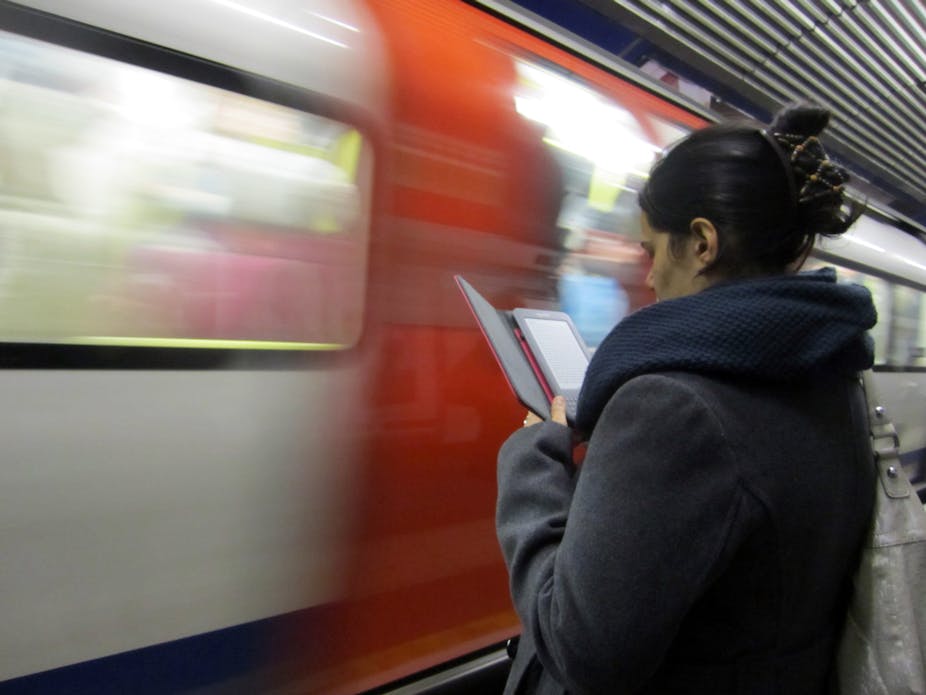E-readers have been a regular sight on public transport for years now but until recently, little has been known about the impact they are having on the publishing industry and readers alike.
For the first time, The Bookseller has published a sales ranking for e-books, revealing the top 50 titles for June this year. The ranking itself makes for interesting reading, with erotic title Entwined with you outstripping the competition, as it were, by miles. The title has secured more than 200,000 digital sales and while it also topped the paper charts for the same month, it shares the digital top 50 with a number of erotic titles that don’t feature at all in the paper bestsellers.
The release of the digital ranking is significant because it allows us to compare print and e-book sales directly for the first time. It also confirms that e-books are here to stay and are likely to have a huge impact on publishing, writing and reading.
Although the fact that an erotic book came out on top grabs all the headlines, it is perhaps more significant that “serious” literary fiction features more prominently on the print book list. More than 80 years after it was first published, F Scott Fitzgerald’s The Great Gatsby has once again landed in the top 20 for paper sales but is nowhere to be seen in the digital charts. This is probably because the Bookseller chart only looks at sales of £2 and over, and Gatsby can be yours in digital form for as little as 77p. Nevertheless, in the digital charts, literary fiction by authors such as Ian McEwan and Hilary Mantel is being outpaced by genre fiction and “middlebrow” titles such as Gone Girl, And the Mountains Echoed and The White Queen.
This is grist to the mill for purists who will undoubtedly argue that standards are declining and that our literary culture is being eroded. So the fact that erotic titles like Bared to you and bestsellers by Julie Kenner only feature on the e-book chart might be taken to suggest that it is somehow easier to bypass guardians of taste and quality if you publish in this way. This is backed up by the finding that Kenner’s books are almost exclusively sold in digital form, with e-book sales accounting for 86% of sales of Release me, which ranks at 34 on the list and 85% of sales for Claim me, at number 38.
Yet encouragement can perhaps be taken from the fact that such charts are also testament to a continuing appetite for reading fiction, and suggest that e-book sales might not so much detract from the sales of print book as open up new markets and new ways of reading and enjoying fiction for many.
The chart echoes many of of the findings from recent research projects which have been exploring the impact of digitisation on readers and reading since early 2012. Researchers on this project conducted a survey of readers who have joined online book clubs and discussion forums and also held focus groups with members of real world book clubs, librarians, teachers and university students. For many of the respondents, e-readers brought new freedoms, not just in terms of what is being read but where and how, as readers happily migrate between devices and find reading on the go much easier with tablet computers, smartphones and e-readers.
However, many pigeonholed their reading, preferring e-readers for leisure and pleasure and print books for reading which was seen as educational or improving.
E-readers do undoubtedly afford more privacy, because no one can see that you are reading 50 Shades of Grey on your commute, but just as significant is cost. The rise of the e-reader has also resulted in high levels of downloads of classic texts as these may be downloaded free when out of copyright. A chart tracking these sales against the modern top sellers could prove even more illuminating.
The Bookseller charts reflect an important change in the way the publishing industry sees e-books as much as showing us what people are really reading when we can’t see the dustcover on their latest novel. Looking behind the headlines, the economic reasons for the seeming success of some titles is also important. Publishing houses and marketing teams can obviously still influence these charts, so it will be interesting to see how this changes as self-published titles and books published cheaply via Amazon become more popular.

